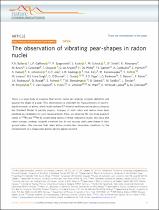| dc.contributor.author | Kenzo, Abrahams | |
| dc.date.accessioned | 2023-01-11T09:49:28Z | |
| dc.date.available | 2023-01-11T09:49:28Z | |
| dc.date.issued | 2019 | |
| dc.identifier.citation | Butler, P.A., Gaffney, L.P., Spagnoletti, P. et al. The observation of vibrating pear-shapes in radon nuclei. Nat Commun 10, 2473 (2019). https://doi.org/10.1038/s41467-019-10494-5 | en_US |
| dc.identifier.issn | 2041-1723 | |
| dc.identifier.uri | http://hdl.handle.net/10566/8272 | |
| dc.description.abstract | There is a large body of evidence that atomic nuclei can undergo octupole distortion and assume the shape of a pear. This phenomenon is important for measurements of electric-dipole moments of atoms, which would indicate CP violation and hence probe physics beyond the Standard Model of particle physics. Isotopes of both radon and radium have been identified as candidates for such measurements. Here, we observed the low-lying quantum states in 224Rn and 226Rn by accelerating beams of these radioactive nuclei. We show that radon isotopes undergo octupole vibrations but do not possess static pear-shapes in their ground states. | en_US |
| dc.language.iso | en_US | en_US |
| dc.publisher | nature communications | en_US |
| dc.subject | nanoscale | en_US |
| dc.subject | crystallinity | en_US |
| dc.subject | TiO2 | en_US |
| dc.subject | nanotubes | en_US |
| dc.subject | electronic | en_US |
| dc.title | The observation of vibrating pear-shapes in radon nuclei | en_US |
| dc.type | Article | en_US |

